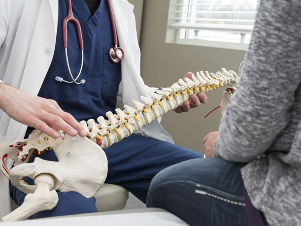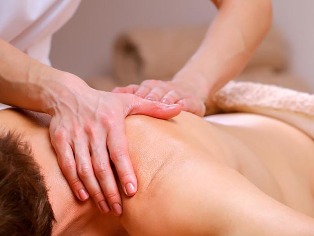If there is lumbar spine osteochondrosis, the symptoms and treatment of this disease will be discussed further, a person's movement is limited, ability to lead a normal life. Nearly half of all patients experience pain complaints in this back. According to the results of Poll Are Options, lumbar osteochondrosis is in second place after respiratory disease.
If until recently the age-related degenerative process was considered the leading cause of pathology, now many more factors causing the disease have been clarified. Before starting therapy, you need to understand what lumbar spine osteochondrosis is.
The disease is a pathological change in the intervertebral disc, accompanied by ligament dystrophy, destruction of the vertebral body itself. This is the lumbar spine that suffers the most, as it experiences a very large load when lifting the load in a sitting position.
Signs of osteochondrosis of the lumbar spine are becoming more pronounced in young people as young as 30 years old. It is impossible to start the disease, as complications are fraught with deformities, paralysis of the lower limbs.
The main symptoms of lumbar osteochondrosis
Lumbar osteochondrosis is a pathological deformity, which in most cases is a natural aging process. But high physical activity on the spine, metabolic disorders, abuse of harmful products and alcohol accelerate this process.
The first signs of pathology do not appear immediately, so therapy does not always begin on time. With lumbar spine osteochondrosis, the symptoms are as follows:
- pain is more frequent pain in the first stage and acute in 2-3 stages of disease development (with sudden movements, discomfort becomes stronger, and during rest in bed disappears);
- with osteochondrosis, a sensation of weakness appears in the foot (tendon reflexes disappear in the lower leg, which can be clearly seen during neurological tests);
- curvature of the lumbar region;
- urinary incontinence and defecation (depending on where the spinal cord is pinched).

Additional symptoms of lumbar osteochondrosis can also be identified: numbness in the lower back, dryness and exfoliation of the skin, changes in its shade (turning blue). Sweating increases in the back area. One of the signs of osteochondrosis in men in the lumbar spine is considered to be erectile dysfunction.
With lumbar spine osteochondrosis, symptoms vary in severity. Some manifestations can be combined into a syndrome.
| Syndrome | Features |
| Ischemic | Here, signs of lumbar osteochondrosis appear due to damage to blood vessels. Arteries begin to spasm (the process becomes permanent over time). This condition is characterized by pain in the muscles of the lower legs and thighs while walking. If the blood vessels pinch and cramp for a long time, then the nutrition of the pelvic organs is disrupted, as is its function. In women, pathology causes problems with the menstrual cycle, the ability to conceive, urination |
| Vertebral | It is characterized by pain with varying intensity and localization. It arises after the load on the lumbar spine: tilting, lifting heavy objects. If a herniated disc occurs, the person may lose sensitivity in the leg. In this case, changes in the spine occur: changes in posture, the person deteriorates, walking becomes problematic |
| Radicular | The vertebrae become unstable, compressing not only the nerve roots, but also the blood vessels. Symptoms of the syndrome are pain in the pinch area. Unpleasant sensations spread to the back and legs. A person experiences an increase in muscle tone, he has to change his gait. If there is no treatment for osteochondrosis, the nerve roots become inflamed. This condition is accompanied by edema of the body tissues that surround the spine. The blood begins to stagnate, the intoxication process begins. With radicular syndrome, pain is observed in other joints. In addition to these symptoms, the feeling of "goose bumps" appears in the lower back (lower back). In very difficult cases, the patient can no longer move freely |
People suffering from osteochondrosis of the lumbar spine must undergo a full examination to find out how severe the disease is, and to determine the therapeutic regimen.

Degree of lumbar osteochondrosis
Lumbar osteochondrosis develops gradually. There is a stage of development of such pathology:
- First. In this case, the nucleus pulposus, located inside the disc, begins to move and change. Cracks appear on the fibrous rings. The nerve roots become irritated, which is marked by back pain. At this stage of osteochondrosis, the discomfort is still localized, i. e. , symptoms are only felt in the area of the damaged disc. Sometimes it is lumbago, but in the first stage of its development, there is often a dull ache. Discomfort in osteochondrosis increases after load on the lumbar spine.
- Second. Here occurs the destruction of fibrous rings. The mobility of injured vertebrae increases, while muscle tissue becomes tense. The distance between them decreases, they can move each other. It becomes more difficult for a person to move, as he is quickly tired, feeling uncomfortable in the lumbar region. The pain spreads to the thighs, legs, back. The person has increased sweating.
- Third. At this stage of the disease, the pain increases many times, as the fibrous ring breaks. In this case, the nucleus pulposus leaves its place and forms a hernia. The patient feels acute pain and lumbago when the tissues and nerve roots are compressed. The discomfort becomes constant and unbearable. Internal organ work is disrupted.
- Fourth. Spinal cord damage occurs. It is very difficult for a person to move, but the symptoms of pain become less obvious. This does not mean that the pathology is no longer evolving. This situation is a signal that someone will immediately sit in a wheelchair. In addition, in the damaged disc area, osteophytes grow, exacerbating the condition, muscle atrophy.
If the progression of the disease is not monitored and therapy is not started in a timely manner, the spine will collapse and recover without risky and difficult surgery will not succeed.
What to do in the event of a worsening of the disease
Lumbar osteochondrosis is a difficult disease that is better not brought to the final stage. It quickly becomes chronic, as the most effective treatment can only stop the progression of the pathology or slow it down.
If there is severe pain in the back area, and a person is unable to move normally, this indicates an increase in pathological processes. Often it occurs in patients who do not follow the doctor's recommendations. In the event of an exacerbation, one should follow the following rules:
- It is better to leave physical activity completely for the time it takes to restore normal body function. It is better to lie in a comfortable position that does not cause discomfort. It is good if the patient uses a hard mattress, as the body in this case (lumbar region in particular) does not sag.
- A semi-rigid corset can be used to reduce the load on the back. It will restrict movement suddenly.
- To reduce the severity of pain in osteochondrosis, you need to gently bend the leg at the knee in the affected area. This will help reduce muscle tension and relieve pinched nerve tissue.
- In difficult cases, the applicator can be used, but must be used with caution. The procedure is performed twice a day for 30 minutes.
- After a massage that gradually restores normal blood circulation and muscle tone, you should use an anti-inflammatory ointment.

It is impossible to heat the affected area on the first day after the onset of deterioration. Dry heat is only used on the second day, when the peak of pain has passed. Otherwise, tissue edema will increase, and the condition of patients with osteochondrosis will worsen.
Disease Diagnostics
Lumbar osteochondrosis requires a serious approach and complex therapy. It becomes easier for the patient if he is taking the right medication, doing the exercises prescribed by the doctor. To choose a therapeutic regimen, the patient needs to be examined. The following diagnostic methods stand out:
- X-ray. If the lumbar joint is affected, evaluation with x-ray is considered primary. Pictures are taken in several projections. On it you can see the damage to the disc, the condition of the spinal canal. Each projection must be perpendicular to the previous one.
- MRI or CT. The procedure shown helps to more accurately identify what factors trigger the development of osteochondrosis, under what conditions not only the spine, but also soft tissues, blood vessels, nerve endings. At the same time, the person does not feel uncomfortable.
- External examination with palpation of the damaged area and neurological examination.
Only a thorough diagnosis will determine if a person actually has osteochondrosis.
Treatment of lumbar osteochondrosis
If lumbar osteochondrosis therapy is not carried out, the patient has complications such as protrusion, spondyloarthrosis, hernia, sciatic nerve inflammation, narrowing of the spinal canal, and dysfunction of the pelvic organs. The man also began to drown, he suffered from paresis and paralysis of the legs.
Treatment of lumbar spine osteochondrosis prescribes several tasks. First, it is necessary to get rid of the inflammation that causes pain in this disease. Naturally, it is necessary to stop the unpleasant symptoms themselves, as well as strengthen the muscular corset in the lumbar region, the lower leg.
This therapy can relieve swelling and soft tissue spasms. Patients are determined ways and procedures designed to improve organ function, regulate blood circulation, restore metabolic processes in the body, and even expand range of motion. Since osteochondrosis of the patient's lumbar spine will be treated for a long time, you need to choose a method that will have a good effect and cause minimal harm. Medications, alternative treatments, physiotherapy, LF and other methods are used.
Surgery
In further cases, when the development of the disease has reached its final stage, lumbar osteochondrosis requires surgical intervention. The help of a surgeon is needed if there are complications that impair organ function, vertebral hernia. An emergency operation is performed if there is a threat of paralysis in the lower leg.
The most effective intervention is to remove damaged discs. Also widespread is the microsurgical method of treating lumbar spine osteochondrosis using endoscopy. This procedure is less traumatic for the patient and allows him to recover in the shortest possible time.
Physiotherapy
With lumbar osteochondrosis, symptoms (they are treated differently) can be eliminated with the help of physiotherapy procedures. Useful:
- diadynamic currents;
- electrophoresis and phonophoresis;
- magnetic therapy;
- laser treatment.
Physiotherapy procedures will provide maximum benefits in combination therapy, in combination with medications.
Physiotherapy training
Treatment of lumbar osteochondrosis will not be effective without performing a doctor-prescribed therapy. All exercises aim to improve lower back movement, strengthen muscle corsets, and improve spinal stability. Complexes must be done regularly.
Doctors usually prescribe the following exercises: bending in different directions, in a standing position, walking on all fours back and forth, tension of the abdominal muscles in the supine position.

Sort
It can be done only after exacerbation is removed or during remission. Thanks to the procedure, you can not only relax the spasmodic muscles, but also strengthen them. Massage is more effective after bathing. It should be done by a specialist, using the right techniques: caressing, rubbing. This procedure should not be performed if there is an open wound in the back, the person is diagnosed with a dermatological disease or a problem with blood circulation.
Manual therapy
Manual therapy completes the same task as massage, but uses slightly different techniques. You can’t trust your spine to an amateur. Experienced specialists are required for the procedure, which will not be harmful.
Medicine
In the treatment of lumbar spine osteochondrosis, the drug cannot be removed. When choosing it, the general condition of the body, the stage of disease development, is important. To combat osteochondrosis, there are the following most effective groups of drugs:
Analgesics.
- NSAID-This medicine eliminates the inflammation itself and the accompanying pain. They relieve swelling, normalize body temperature.
- Muscle relaxation-This medicine is prescribed by a doctor and is used only when NSAIDs fail. Muscle relaxation helps relieve muscle cramps.
- Chondroprotectors-They keep cartilage in good condition without letting it get damaged. But it is effective only if this layer is not completely erased.
- Anti-inflammatory steroids. They are last appointed in the most advanced cases.
- Multivitamins and vitamin B - Preparations presented help improve NS function.
- Antidepressants (to restore the patient's emotional background).
- Novocaine blockade with Hydrocortisone. They are placed directly on the back from which the pain originated. Blockage is rare, as it can provoke muscle atrophy.
- Preparations to improve blood circulation and microcirculation.
Topical medicine - ointment - has good effectiveness and minimal side effects. If the patient uses folk remedies for therapy, the medications must continue to be taken.
Prevention of lumbar spine osteochondrosis
Osteochondrosis of the lumbar spine can be prevented if you follow these simple preventive rules:
- prevents hypothermia and infection;
- do not lift heavy objects;
- bags are worn alternately on both shoulders;
- follow the rules of drinking and eating properly;
- keep weight within normal limits;
- treating congenital pathology or timely framework;
- go in for a swim, move more, do gymnastics complexes for the lumbar region every day;
- undergoes regular medical examinations.
Basic care of your own health will help prevent complications of lumbar osteochondrosis, and there are many among them, and it is difficult to overcome.

















































